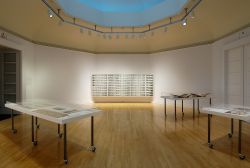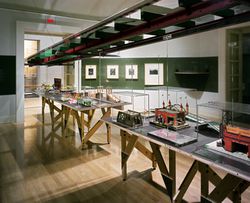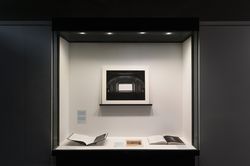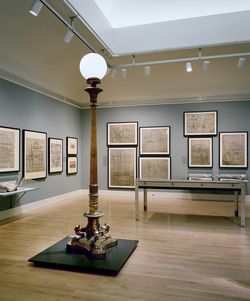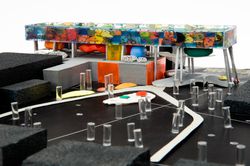archives
Niveau de description archivistique:
Fonds
Joseph Rykwert fonds
AP209
Résumé:
The Joseph Rykwert fonds, 1928-2022, documents Joseph Rykwert’s career as an architectural historian, author and professor. The fonds includes the records for over a dozen monographs written between the mid-1960s and the mid-2010s as well as edited works and articles, and details his teaching and lecturing activities from the 1960s onwards in universities in Europe and the United States. The records highlight Joseph Rykwert’s multidisciplinary approach, which involved archaeology, anthropology and psychoanalysis in his study of the history and theory of architecture and of the urban form. The fonds is composed of textual records, publications and ephemera, and of photographs including multiple albums and a large number of slides; the fonds also documents Joseph Rykwert’s career as an independent designer through drawings realized between the late 1940s and the late 1970s.
1928-2022
Joseph Rykwert fonds
Actions:
AP209
Résumé:
The Joseph Rykwert fonds, 1928-2022, documents Joseph Rykwert’s career as an architectural historian, author and professor. The fonds includes the records for over a dozen monographs written between the mid-1960s and the mid-2010s as well as edited works and articles, and details his teaching and lecturing activities from the 1960s onwards in universities in Europe and the United States. The records highlight Joseph Rykwert’s multidisciplinary approach, which involved archaeology, anthropology and psychoanalysis in his study of the history and theory of architecture and of the urban form. The fonds is composed of textual records, publications and ephemera, and of photographs including multiple albums and a large number of slides; the fonds also documents Joseph Rykwert’s career as an independent designer through drawings realized between the late 1940s and the late 1970s.
archives
Niveau de description archivistique:
Fonds
1928-2022
documents textuels
DR2021:0052:001-039
Description:
The papers in this collection are related to the participation of Barry Campbell in a project to create a 1:50 scale model for the Maison d'Artiste, an unbuilt project designed by architects Theo van Doesburg and Cor van Eesteren in 1923. The model, sponsored by lawyer Piet Sanders and Barry Campbell, was made by Frans Postma and was exhibited at the Stedelijk Museum De Lakenhal (2009-2010) and the Tate Modern (2010) as part of the exhibition "Van Doesburg and the International Avant Garde: Constructing a New World". In 2013, Barry Campbell, Frans Postma and Victor Veldhuijzen van Zanten donated the 1:50 model to Het Nieuwe Instituut/The New Institute in Rotterdam, the Netherlands (Piet Sanders, who died in September, 2012, was also named as a donor). A 1:75 scale model was made for each of the donors. Textual records in the collection include correspondence, a copy of the donor agreement, and a text by Bertus Mulder. Drawings include printouts of plans, elevations, sections, and perspectives. There are also photographs of drawings. Digital files consist of a panorama by Postma & Partner. The collection includes a printout of a photograph of Barry Campbell with the 1:50 model.
2007-2013
Barry Campbell papers related to a 1:50 scale model for the Maison d'Artiste
Actions:
DR2021:0052:001-039
Description:
The papers in this collection are related to the participation of Barry Campbell in a project to create a 1:50 scale model for the Maison d'Artiste, an unbuilt project designed by architects Theo van Doesburg and Cor van Eesteren in 1923. The model, sponsored by lawyer Piet Sanders and Barry Campbell, was made by Frans Postma and was exhibited at the Stedelijk Museum De Lakenhal (2009-2010) and the Tate Modern (2010) as part of the exhibition "Van Doesburg and the International Avant Garde: Constructing a New World". In 2013, Barry Campbell, Frans Postma and Victor Veldhuijzen van Zanten donated the 1:50 model to Het Nieuwe Instituut/The New Institute in Rotterdam, the Netherlands (Piet Sanders, who died in September, 2012, was also named as a donor). A 1:75 scale model was made for each of the donors. Textual records in the collection include correspondence, a copy of the donor agreement, and a text by Bertus Mulder. Drawings include printouts of plans, elevations, sections, and perspectives. There are also photographs of drawings. Digital files consist of a panorama by Postma & Partner. The collection includes a printout of a photograph of Barry Campbell with the 1:50 model.
documents textuels
2007-2013
Selon une légende chinoise connue au Japon, une variété d’arbre, le katsura géant, avait été plantée sur la lune, d’où le proverbe : « Avec les yeux on peut voir le katsura, mais on ne peut avec les mains le toucher ». Cette maxime célébrant la quête d’un absolu traduit bien l’esprit d’Embarquement pour Katsura, qui poursuit cette recherche de l’identité et de l’idéal que(...)
Salle octogonale, vitrines et salle Sottsass
9 décembre 1998 au 28 mars 1999
Embarquement pour Katsura : Irene F. Whittome au CCA
Actions:
Description:
Selon une légende chinoise connue au Japon, une variété d’arbre, le katsura géant, avait été plantée sur la lune, d’où le proverbe : « Avec les yeux on peut voir le katsura, mais on ne peut avec les mains le toucher ». Cette maxime célébrant la quête d’un absolu traduit bien l’esprit d’Embarquement pour Katsura, qui poursuit cette recherche de l’identité et de l’idéal que(...)
Salle octogonale, vitrines et salle Sottsass
Projet
AP207.S1.1971.PR04
Description:
This project series documents Pettena's performance "Vestirsi Di Siede", also know in English as "Wearable Chairs". The performance was carried out between 3 pm and 5 pm on February 12, 1971, in the streets of Minneapolis by ten students of Pettena at the Minneapolis College of Art and Design. The students, each wearing a portable chair harnessed on their back, wandered around the city, either by foot or by bus, and than returned to the college. "In this performance, it was the body that activated and gave meaning to the object: the chair only taking on meaning when carried, otherwise, it became disjointed." [1] The chairs were then put on display at the Minneapolis Institute of Art. A second edition of the performance was also carried out with the students from Nuova Accademia di Belle Arti (NABA) in Milan, 2011, and an installation of the chairs was presented at the exhibition "Un art pauvre" at the Centre Pompidou in 2016. The project series contains photographs of the performance by the students of the Minneapolis College of Art and Design and photographs of the exhibit at the Minneapolis Institute of Art in 1971. It also contains three sketches for the chairs, a drawing of the performance and a statement about the perfomance. The project series also includes photographs of the performance of the NABA students in 2011. Source: [1] FRAC Centre-Val de Loire, http://www.frac-centre.fr/_en/art-and-architecture-collection/pettena-gianni/wearable-chairs-verstirsi-siede-317.html?authID=148&ensembleID=1286 (last accessed 11 November 2019)
1971-2017
Vestirsi Di Siede [Wearable Chairs] (1971)
Actions:
AP207.S1.1971.PR04
Description:
This project series documents Pettena's performance "Vestirsi Di Siede", also know in English as "Wearable Chairs". The performance was carried out between 3 pm and 5 pm on February 12, 1971, in the streets of Minneapolis by ten students of Pettena at the Minneapolis College of Art and Design. The students, each wearing a portable chair harnessed on their back, wandered around the city, either by foot or by bus, and than returned to the college. "In this performance, it was the body that activated and gave meaning to the object: the chair only taking on meaning when carried, otherwise, it became disjointed." [1] The chairs were then put on display at the Minneapolis Institute of Art. A second edition of the performance was also carried out with the students from Nuova Accademia di Belle Arti (NABA) in Milan, 2011, and an installation of the chairs was presented at the exhibition "Un art pauvre" at the Centre Pompidou in 2016. The project series contains photographs of the performance by the students of the Minneapolis College of Art and Design and photographs of the exhibit at the Minneapolis Institute of Art in 1971. It also contains three sketches for the chairs, a drawing of the performance and a statement about the perfomance. The project series also includes photographs of the performance of the NABA students in 2011. Source: [1] FRAC Centre-Val de Loire, http://www.frac-centre.fr/_en/art-and-architecture-collection/pettena-gianni/wearable-chairs-verstirsi-siede-317.html?authID=148&ensembleID=1286 (last accessed 11 November 2019)
Project
1971-2017
L’artiste allemand Dieter Appelt présente une œuvre majeure commandée par le CCA et inspirée du spectaculaire pont ferroviaire construit sur le Forth à la fin du XIXe siècle près d’Édimbourg, en Écosse. Dieter Appelt : Forth Bridge – cinéma. Espace métrique est la deuxième de quatre expositions composant la série Tangente, qui amène des artistes contemporains à établir un(...)
Salle octogonale
9 mars 2005 au 22 mai 2005
Dieter Appelt : Forth Bridge – cinéma. Espace métrique
Actions:
Description:
L’artiste allemand Dieter Appelt présente une œuvre majeure commandée par le CCA et inspirée du spectaculaire pont ferroviaire construit sur le Forth à la fin du XIXe siècle près d’Édimbourg, en Écosse. Dieter Appelt : Forth Bridge – cinéma. Espace métrique est la deuxième de quatre expositions composant la série Tangente, qui amène des artistes contemporains à établir un(...)
Salle octogonale
Jouets et transports
Tout nouveau moyen de transport ou toute modification apportée à un système existant de mobilité urbaine – l’élargissement des tranchées permettant aux voies ferrées de se relier à un terminus ou à une jonction, l’extension des gares de triage desservant les systèmes de transport métropolitains et de banlieue, la multiplication des bretelles des ponts, des autoroutes(...)
Salle octogonale
15 novembre 2000 au 1 avril 2001
Jouets et transports
Actions:
Description:
Tout nouveau moyen de transport ou toute modification apportée à un système existant de mobilité urbaine – l’élargissement des tranchées permettant aux voies ferrées de se relier à un terminus ou à une jonction, l’extension des gares de triage desservant les systèmes de transport métropolitains et de banlieue, la multiplication des bretelles des ponts, des autoroutes(...)
Salle octogonale
Série(s)
CD041.S2
Description:
This series documents nine projects by the firm Rosen, Caruso, Vecsei Architects. The practice was opened in partnership by Bernard Rosen, Irving Caruso and André Vecsei. The latter was partner until his departure in 1984 when he founded Vecsei Architects with Eva Hollo Vecsei. During his time at Rosen, Caruso, Vecsei Architect, André was the partner in charge of several projects including: Twenty-five story apartment building, Lincoln Avenue and St. Mathieu Street, Montréal, Québec (circa 1962-1974); Nursing home, Côte-Saint-Luc, Québec (circa 1962-1970); Senoir’s home, Manoir Outremont, Outremont, Québec (1977); Intermunicipal library, Pierrefonds, Montréal, Québec (circa 1980-1984). Eva Hollo Vecsei did not work for the firm Rosen, Caruso, Vecsei Architects. This series documents the following projects: Golf clubhouse, Mirabel, Québec (circa 1962-1970); Fraternity house, Montréal, Québec (circa 1964); Marina, Expo 67, Montréal, Québec (1965-1966); Engineering Institute of Canada, Montréal, Québec (circa 1967); International Civil Aviation Organisation building, Montréal, Québec (circa 1974); Seniors home, Manoir Outremont, Outremont, Québec (1977); Fort de la Montagne, Westmount, Québec (circa 1980-1982); and City hall and municipal library, Côte-Saint-Luc, Québec (circa 1981-1984). Also included are sketches from 1962 to 1984 for an unidentified project. Collection material in this series was produced between 1974 and 2006. Documenting the series are architectural records, such as conceptual, design, presentation, and working drawings, as well as photographs, digital material (mainly photographs), and a sketchbook. The bulk of the material was produced between 1981 and 1984, which corresponds to the period during which André Vecsei worked on the city hall and municipal library, in Côte-Saint-Luc, Québec. Documenting this project are working drawings and a few digitized sketches and photographs.
1974-2006
Rosen, Caruso, Vecsei Architects (1962-1984)
Actions:
CD041.S2
Description:
This series documents nine projects by the firm Rosen, Caruso, Vecsei Architects. The practice was opened in partnership by Bernard Rosen, Irving Caruso and André Vecsei. The latter was partner until his departure in 1984 when he founded Vecsei Architects with Eva Hollo Vecsei. During his time at Rosen, Caruso, Vecsei Architect, André was the partner in charge of several projects including: Twenty-five story apartment building, Lincoln Avenue and St. Mathieu Street, Montréal, Québec (circa 1962-1974); Nursing home, Côte-Saint-Luc, Québec (circa 1962-1970); Senoir’s home, Manoir Outremont, Outremont, Québec (1977); Intermunicipal library, Pierrefonds, Montréal, Québec (circa 1980-1984). Eva Hollo Vecsei did not work for the firm Rosen, Caruso, Vecsei Architects. This series documents the following projects: Golf clubhouse, Mirabel, Québec (circa 1962-1970); Fraternity house, Montréal, Québec (circa 1964); Marina, Expo 67, Montréal, Québec (1965-1966); Engineering Institute of Canada, Montréal, Québec (circa 1967); International Civil Aviation Organisation building, Montréal, Québec (circa 1974); Seniors home, Manoir Outremont, Outremont, Québec (1977); Fort de la Montagne, Westmount, Québec (circa 1980-1982); and City hall and municipal library, Côte-Saint-Luc, Québec (circa 1981-1984). Also included are sketches from 1962 to 1984 for an unidentified project. Collection material in this series was produced between 1974 and 2006. Documenting the series are architectural records, such as conceptual, design, presentation, and working drawings, as well as photographs, digital material (mainly photographs), and a sketchbook. The bulk of the material was produced between 1981 and 1984, which corresponds to the period during which André Vecsei worked on the city hall and municipal library, in Côte-Saint-Luc, Québec. Documenting this project are working drawings and a few digitized sketches and photographs.
Series
1974-2006
Miroirs / Mirrors
Miroirs/ Mirrors prend forme à travers un dialogue indirect avec l’exposition L’histoire, par ailleurs: Go Hasegawa, Kersten Geers, David Van Severen, qui prend racine dans les références et les résonnances partagées entre les travaux de deux pratiques contemporaines mises en présence de l’histoire. Alors que L’histoire, par ailleurs se fonde sur limpression que lon a du(...)
Vitrines
22 juin 2017 au 14 janvier 2018
Miroirs / Mirrors
Actions:
Description:
Miroirs/ Mirrors prend forme à travers un dialogue indirect avec l’exposition L’histoire, par ailleurs: Go Hasegawa, Kersten Geers, David Van Severen, qui prend racine dans les références et les résonnances partagées entre les travaux de deux pratiques contemporaines mises en présence de l’histoire. Alors que L’histoire, par ailleurs se fonde sur limpression que lon a du(...)
Vitrines
L’exposition se penche sur la période durant laquelle Montréal, cité marchande du XIXe siècle, se transforme et devient métropole du Canada. Y sont mis en lumière les éléments qui ont fait de Montréal une ville de grande influence aux plans politique, social et économique ainsi que le caractère unique de son architecture. Parmi les quelque 350 pièces regroupées, on(...)
Salles principales
18 mars 1998 au 24 mai 1998
Montréal métropole, 1880-1930
Actions:
Description:
L’exposition se penche sur la période durant laquelle Montréal, cité marchande du XIXe siècle, se transforme et devient métropole du Canada. Y sont mis en lumière les éléments qui ont fait de Montréal une ville de grande influence aux plans politique, social et économique ainsi que le caractère unique de son architecture. Parmi les quelque 350 pièces regroupées, on(...)
Salles principales
L’exposition présente les œuvres de l’architecte britannique Will Alsop, préparatoires au Sharp Centre for Design de l’Ontario College of Art and Design (OCAD) de Toronto, et s’attache en particulier au rôle qu’a joué la peinture dans son processus de création. La construction du Sharp Centre for Design de l’OCAD, conçu en collaboration avec Robbie/Young + Wright, s’est(...)
Salle octogonale
13 juin 2008 au 5 octobre 2008
Will Alsop : OCAD, un manifeste urbain
Actions:
Description:
L’exposition présente les œuvres de l’architecte britannique Will Alsop, préparatoires au Sharp Centre for Design de l’Ontario College of Art and Design (OCAD) de Toronto, et s’attache en particulier au rôle qu’a joué la peinture dans son processus de création. La construction du Sharp Centre for Design de l’OCAD, conçu en collaboration avec Robbie/Young + Wright, s’est(...)
Salle octogonale

